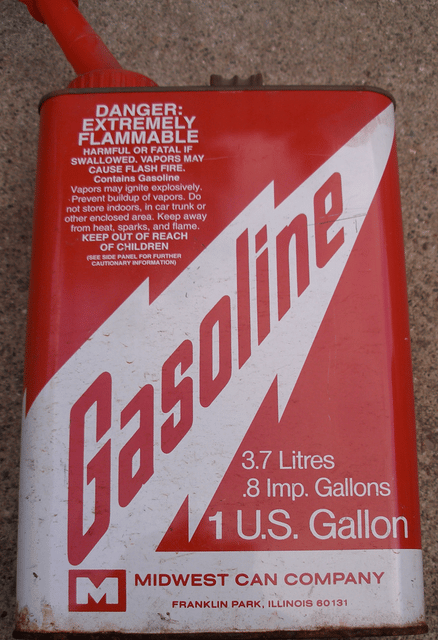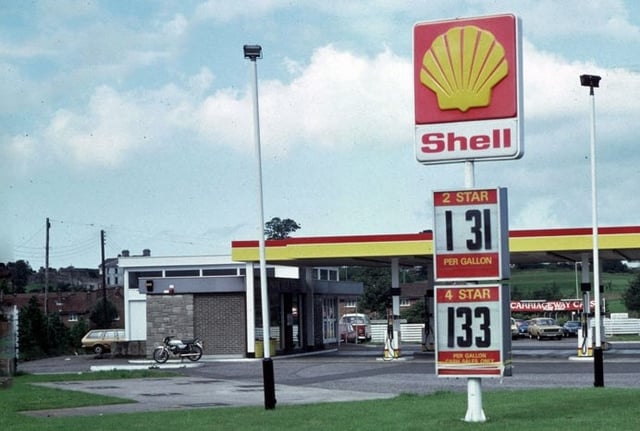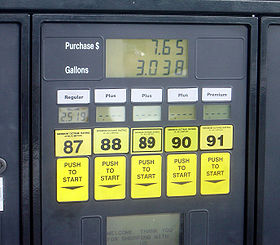Gallon

Gallon

| Gallon | |
|---|---|
| General information | |
| Unit of | Volume |
| Symbol | gal |
| Conversions (imperial) | |
| 1 imp gal in... | ... is equal to... |
| SI-compatible units | 4.54609 L |
| US customary units | ≈1.200950 US gal |
| US customary units | ≈277.4194 in |
| Conversions (US) | |
| 1 US gal in... | ... is equal to... |
| SI-compatible units | 3.785411784 L |
| Imperial units | ≈0.8326742 imp gal |
| Imperial units | 231 in |
| US Dry Gallon | ≈0.859367 US dry gal |
The gallon is a unit of measurement for volume and fluid capacity in both the US customary units and the British imperial systems of measurement. Three significantly different sizes are in current use:
the imperial gallon, defined as 4.54609 litres, which is used in the United Kingdom, Canada, and some Caribbean nations;
the US gallon defined as 231 cubic inches (exactly 3.785411784 litres), which is used in the US and some Latin American and Caribbean countries; and
the US dry gallon, defined as 1⁄8 US bushel (exactly 4.40488377086 litres).
There are four quarts in a gallon and eight pints in a gallon, and they have different sizes in different systems.
The IEEE standard symbol for the gallon is gal.[1]
| Gallon | |
|---|---|
| General information | |
| Unit of | Volume |
| Symbol | gal |
| Conversions (imperial) | |
| 1 imp gal in... | ... is equal to... |
| SI-compatible units | 4.54609 L |
| US customary units | ≈1.200950 US gal |
| US customary units | ≈277.4194 in |
| Conversions (US) | |
| 1 US gal in... | ... is equal to... |
| SI-compatible units | 3.785411784 L |
| Imperial units | ≈0.8326742 imp gal |
| Imperial units | 231 in |
| US Dry Gallon | ≈0.859367 US dry gal |
Definitions
The gallon currently has one definition in the imperial system, and two definitions (liquid and dry) in the US customary system. Historically, there were many definitions and redefinitions.
English system gallons
There were a number of systems of liquid measurements in the United Kingdom prior to the 19th century.[2]
Winchester or Corn Gallon was 272 in3 (157 fl oz) (1697 Act 8 & 9 Will III c22) Henry VII (Winchester) corn gallon from 1497 onwards was 154.80 fl oz Elizabeth I corn gallon from 1601 onwards was 155.70 fl oz William III corn gallon from 1697 onwards was 156.90 fl oz
Old English (Elizabethan) Ale Gallon was 282 in3 (162 fl oz) (1700 Act 11 Will III c15)
Old English (Queen Anne) Wine Gallon was standardized as 231 in3 (133 fl oz) in the 1706 Act 5 Anne c27, but it differed before that: London 'Guildhall' gallon (before 1688) was 129.19 fl oz Jersey gallon (from 1562 onwards) was 139.20 fl oz Guernsey gallon (17th century origins till 1917) was 150.14 fl oz
Irish Gallon was 217 in3 (125 fl oz) (1495 Irish Act 10 Hen VII c22 confirmed by 1736 Act Geo II c9)
Imperial gallon

A Shell petrol station selling 2and 4 (leaded petrol) by the gallon in the UK c. 1980
The British imperial gallon is now defined as exactly 4.54609 litres (about 277.42 cubic inches).[3] It is used in some Commonwealth countries. Until 1976 it was based on the volume of 10 pounds (approximately 4.54 kg) of water at 62 °F (17 °C).[4][4] There are four quarts in a gallon, the imperial pint is defined as 0.56826125 litres (i.e. 1/8 gallon) and there are 20 imperial fluid ounces in an imperial pint.[3]
US liquid gallon

A fuel station in the United States displaying fuel prices per US gallon
The US gallon is legally defined as 231 cubic inches, which is exactly 3.785411784 litres.[6][7] A US liquid gallon of water weighs about 8.34 pounds or 3.78 kilograms at 62 °F (17 °C), making it about 16.6% lighter than the imperial gallon. There are four quarts in a gallon, two pints in a quart and 16 US fluid ounces in a US pint, which makes the US fluid ounce equal to 1/128 of a US gallon. In order to overcome the effects of expansion and contraction with temperature when using a gallon to specify a quantity of material for purposes of trade, it is common to define the temperature at which the material will occupy the specified volume. For example, the volume of petroleum products[8] and alcoholic beverages[9] are both referenced to 60 °F (15.6 °C) in government regulations.
US dry gallon
Since the dry measure is one-eighth of a US Winchester bushel of 2150.42 cubic inches, it is therefore equal to exactly 268.8025 cubic inches, which is 4.40488377086 L. The US dry gallon is not used in commerce, and is also not listed in the relevant statute, which jumps from the dry quart to the peck.[10]
Worldwide usage of gallons
The gallon was removed from the list of legally defined primary units of measure catalogued in the EU directive 80/181/EEC for trading and official purposes, with effect from 31 December 1994. Under the directive the gallon could still be used, but only as a supplementary or secondary unit.[18] One of the effects of this directive was that the United Kingdom amended its own legislation to replace the gallon with the litre as a primary unit of measure in trade and in the conduct of public business, effective from 30 September 1995.[19][20][21]
Ireland also passed legislation in response to the EU directive, with the effective date being 31 December 1993.[22] Though the gallon has ceased to be the legally defined primary unit, it can still be legally used in both the UK and Ireland as a supplementary unit.
Antigua and Barbuda planned to switch over to using litres by 2015,[28] but due to various issues, the switch-over was only effected in 2019.
Other than the United States, the US gallon is still used in Belize, Colombia, The Dominican Republic, Ecuador, El Salvador, Guatemala, Haiti, Honduras, Liberia, Nicaragua, and Peru, but only for the sale of gasoline; all other products in these countries are sold in litres, or multiples and submultiples of a litre.[26]
In the Turks & Caicos Islands, both the U.S. gallon and Imperial gallon are used. This is due to an increase in tax duties which was disguised by levying the same duty on the U.S. gallon (3.79 L) as was previously levied on the Imperial gallon (4.55 L).[39]
Relationship to other units
Both the US liquid and imperial gallon are divided into four quarts (quarter gallons), which in turn are divided into two pints, which in turn are divided into two cups, which in turn are further divided into two gills. Thus, both gallons are equal to four quarts, eight pints, sixteen cups, or thirty-two gills.
The imperial gill is further divided into five fluid ounces whereas the US gill is divided into four fluid ounces, meaning an imperial fluid ounce is 1/20 of an imperial pint, or 1/160 of an imperial gallon, while a US fluid ounce is 1/16 of a US pint, or 1/128 of a US gallon. Since the imperial gallon, quart, pint, cup and gill are approximately 20% larger than their US counterparts, these are not interchangeable, while the imperial fluid ounce is only approximately 4% smaller than the US fluid ounce, and they are often therefore used interchangeably.
History
The term derives most immediately from galun, galon in Old Northern French, but the usage was common in several languages, for example jale in Old French and gęllet (bowl) in Old English. This suggests a common origin in Romance Latin, but the ultimate source of the word is unknown.[42]
The gallon originated as the base of systems for measuring wine and beer in England. The sizes of gallon used in these two systems were different from each other: the first was based on the wine gallon (equal in size to the US gallon), and the second one either the ale gallon or the larger imperial gallon.
By the end of the 18th century, there were three definitions of the gallon in common use:
The corn gallon, or Winchester gallon, of about 268.8 cubic inches (≈ 4.405 L),
The wine gallon, or Queen Anne's gallon, which was 231 cubic inches[43] (≈ 3.785 L), and
The ale gallon of 282 cubic inches (≈ 4.622 L).
The corn or dry gallon is used (along with the dry quart and pint) in the United States for grain and other dry commodities. It is one-eighth of the (Winchester) bushel, originally defined as a cylindrical measure of 18+1/2 inches in diameter and 8 inches in depth, which made the dry gallon 8 in × (9+1/4 in)2 × π ≈ 2150.42017 cubic inches. The bushel was later defined to be 2150.42 cubic inches exactly, thus making its gallon exactly 268.8025 in3 (4.40488377086 L); in previous centuries, there had been a corn gallon of between 271 and 272 cubic inches.
The wine, fluid, or liquid gallon has been the standard US gallon since the early 19th century. The wine gallon, which some sources relate to the volume occupied by eight medieval merchant pounds of wine, was at one time defined as the volume of a cylinder 6 inches deep and 7 inches in diameter, i.e. 6 in × (3+1/2 in)2 × π ≈ 230.907 06 cubic inches. It was redefined during the reign of Queen Anne in 1706 as 231 cubic inches exactly, the result of the earlier definition with π approximated to 22/7. Although the wine gallon had been used for centuries for import duty purposes, there was no legal standard of it in the Exchequer, and a smaller gallon (224 cu in) was actually in use, meaning this statute became necessary; it remains the US definition today.
In 1824, Britain adopted a close approximation to the ale gallon known as the imperial gallon, and abolished all other gallons in favour of it. Inspired by the kilogram-litre relationship, the imperial gallon was based on the volume of 10 pounds of distilled water weighed in air with brass weights with the barometer standing at 30 inches of mercury and at a temperature of 62 °F.
In 1963, this definition was refined as the space occupied by 10 pounds of distilled water of density 0.998859 g/mL weighed in air of density 0.001217 g/mL against weights of density 8.136 g/mL (the original "brass" was refined as the density of brass alloys vary depending on metallurgical composition), which was calculated as 4.546091879 L to ten significant figures.[4]
The precise definition of exactly 4.54609 cubic decimetres (also 4.54609 L, ≈ 277.419433 in3) came after the litre was redefined in 1964.
This was adopted shortly afterwards in Canada, and adopted in 1976 in the United Kingdom.[4]
Sizes of gallons
Historically, gallons of various sizes were used in many parts of Western Europe.
In these localities, it has been replaced as the unit of capacity by the litre.
| Volume | Definition | Inverted volume(gallons per cubic foot) | Approx.weight ofwater (poundsper gallon@ 62 °F) | Cylindrical approximation | |||
|---|---|---|---|---|---|---|---|
| (cu in) | (L] ordm3) | Diameter(in) | Height(in) | Relative error(%) | |||
| 231 | 3.785411784 | statute of 5th of Queen Anne (UK wine gallon, standard US gallon) | 7.48 | 8.33 | 7 | 6 | 0.04 |
| 268.8025 | 4.40488377086 | Winchester, statute 13 + 14 byWilliam III(corn gallon, US dry gallon) | 6.43 | 9.71 | 18.5 | 1 | 0.00001 |
| ≈ 277.4194 | 4.54609 | standard imperial gallon (metric; adopted 1964 in Canada, 1976 in UK) | ≈ 6.23 | 10 | 5⅔ | 11 | 0.0002 |
| Volume | Definition | Inverted volume(gallons per cubic foot) | Approx.weight ofwater (poundsper gallon@ 62 °F) | Cylindrical approximation | |||
|---|---|---|---|---|---|---|---|
| (cu in) | (L] ordm3) | Diameter(in) | Height(in) | Relative error(%) | |||
| 216 (Romanunciae) | ≈ 3.53961 | Romancongius | 8 | 7.8 | 5 | 11 | 0.01 |
| 224 | ≈ 3.67070 | preserved at theGuildhall, London(old UK wine gallon) | 7.71 | 8.09 | 9 | 3.5 | 0.6 |
| 264.8 | ≈ 4.33929 | ancient Rumford quart (1228) | 6.53 | 9.57 | 7.5 | 6 | 0.1 |
| 265.5 | ≈ 4.35077 | Exchequer (Henry VII, 1497, with rim) | 6.51 | 9.59 | 13 | 2 | 0.01 |
| 266.25 | ≈ 4.36306 | ancient Rumford (1228) | |||||
| 271 | ≈ 4.44089 | Exchequer (1601,E.) (oldcorngallon) | 6.38 | 9.79 | 4.5 | 17 | 0.23 |
| 272 | ≈ 4.45728 | corn gallon (1688) | |||||
| ≈ 277.2026 | ≈ 4.54254 | statute 12 of Anne (coal gallon) =33/32corn gallons | 6.23 | 10 | |||
| ≈ 277.274 | ≈ 4.54370 | Imperial Gallon, as originally determined in 1824 | 6.23 | 10 | |||
| ≈ 277.4195 | 4.546091879 | Imperial gallon as re-determined in 1895 and defined in 1963 | ≈ 6.23 | 10 | |||
| 278 | ≈ 4.55560 | Exchequer (Henry VII, with copper rim) | 6.21 | 10.04 | |||
| 278.4 | ≈ 4.56216 | Exchequer (1601 and 1602 pints) | 6.21 | 10.06 | |||
| 280 | ≈ 4.58838 | Exchequer (1601 quart) | 6.17 | 10.1 | |||
| 282 | ≈ 4.62115 | Treasury (beer and ale gallon pre-1824) | 6.13 | 10.2 | |||